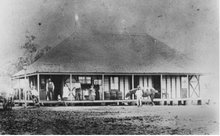
Like many waterways, the Brisbane River was a natural highway for inland exploration. At the time of the explorers, Cunningham and John Oxley the river was fringed by a variety of open grasslands, rain and other forests. In 1823 Oxley explored eighty kilometres inland and his reports directly led to the foundation of a penal settlement on the river.
 Yesterday evening I travelled upstream by RiverCat ferry from the city to St. Lucia. A damp wind mingled with raindrops blew in my face and my mind was on those early settlers. I thought about them travelling upstream by steamer, watching the forests and grassland passing by and wondering about their future. My view was of freeways, galleries, museums, commerce and expensive housing disappearing in the wake of the rapidly moving catamaran. Wandering around the CBD in the drizzle, I saw a building built in 1860 and thought that the Jaeckels would have seen that as they were waiting for their steamer to take them to Ipswich. For one moment, a family of migrants standing with all their possessions waiting on a riverbank was more real to me than the Christmas crowds, lights and bustle.
Yesterday evening I travelled upstream by RiverCat ferry from the city to St. Lucia. A damp wind mingled with raindrops blew in my face and my mind was on those early settlers. I thought about them travelling upstream by steamer, watching the forests and grassland passing by and wondering about their future. My view was of freeways, galleries, museums, commerce and expensive housing disappearing in the wake of the rapidly moving catamaran. Wandering around the CBD in the drizzle, I saw a building built in 1860 and thought that the Jaeckels would have seen that as they were waiting for their steamer to take them to Ipswich. For one moment, a family of migrants standing with all their possessions waiting on a riverbank was more real to me than the Christmas crowds, lights and bustle.
No comments:
Post a Comment